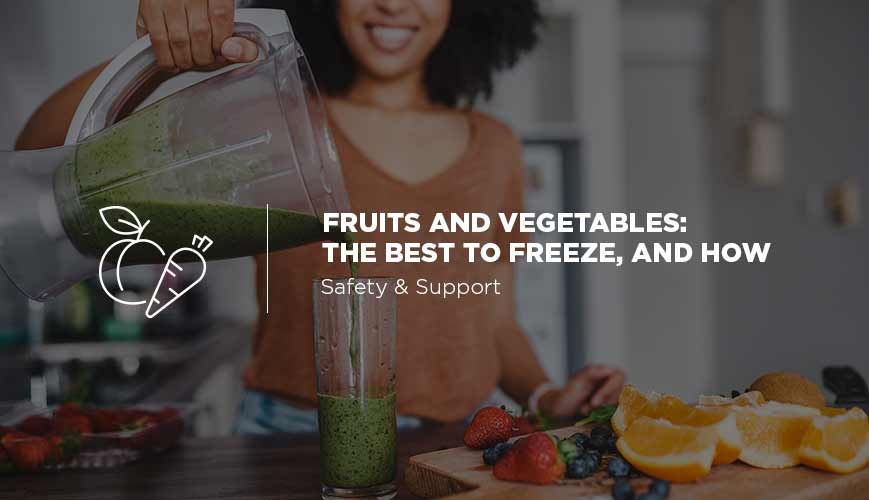Fruits and Vegetables: The Best to Freeze, and How
By Sara Butler

With people trying to stay in as much as they can these days, it’s a good time to learn more about freezing fruits and vegetables. While fresh produce is great to have on hand for your morning smoothie, it doesn’t tend to stay fresh for long. This is where frozen fresh fruits and vegetables come in handy. Here are some of the best fruits and veggies to freeze and how to do it right.
Are Frozen Foods Healthy?
Many people assume that fresh foods are healthier than frozen, but that’s not necessarily true. Frozen fruits and vegetables are flash-frozen at their peak, preserving all of their essential nutrients. Fresh fruit and veg, while nutritious at their peak, will start to lose their nutritional punch as time goes on. When you freeze your produce, then you’re helping to preserve the nutrients until you can use it -- and that’s helpful when you can’t get to the store for more every few days.
Best Fruits to Freeze and How to Do It
Some fruits that freeze well include:
Blueberries
These berries freeze incredibly well and can keep in the freezer for up to one year. All you need to do is lay the blueberries out on a tray to dry them completely and then place them in the freezer. Once they’re frozen, place them in a bag and store in the freezer.
Pro blueberry tip: Do not wash the blueberries before you freeze them. Doing so will toughen the skins and make their texture less appetizing when you go to use them.
Strawberries
Wash the berries and remove the hull and stem. Cut the large ones in half and place on a baking sheet for 30 minutes in the freezer. Then place in freezer bags for storage.
Cherries
Wash the cherries and remove the pits and the stem if you want. Then place them on a baking sheet and freeze for 30 minutes. Once they’re frozen, pack them in freezer bags for storage.
Stone Fruit: Peaches, Plums, and Nectarines
Wash each piece of fruit and then remove the pit and section them up into sixths. Then place on a baking sheet and freeze for 30 minutes. Then place in freezer bags for storage.
Best Vegetables to Freeze and How to Do It
Some vegetables that freeze the best include:
Asparagus
Asparagus freezes well in order for you to enjoy it later. All you need to do is wash it and cut off any of the woody parts at the bottom. Get a pot of water boiling and then blanch the asparagus for about three minutes; afterward, plunge it into a bowl of ice water to stop the cooking process. Drain it and lay the asparagus out on a wax paper-lined baking sheet. Freeze for 30 minutes, then pack them in freezer bags to store in the freezer.
Carrots
Scrub the carrots clean and cut them up how you want. Blanch in boiling water for three minutes, chill in ice water for three minutes, then freeze as you did the asparagus for 30 minutes and pack into freezer bags for storage in the freezer.
Brussels Sprouts
Trim the Brussels sprouts and then blanch in boiling water, cool, drain, and place in freezer bags for storage.
Corn
Clean your corn completely ensuring that all the silk is removed. Cut off the top of the cob and wash a second time, then blanch in boiling water for between five and seven minutes. The larger the cob, the more time it will need to be blanched. Next, chill for five to seven minutes and then wrap each individual cobb in plastic wrap and place all of them in a freezer bag together for storage.
Spinach
You can choose to blanch spinach or just pack it into a freezer bag and store. Blanched spinach will last for up to a year while non-blanched will last for about six months. If you don’t blanch it, rinse it well and pat dry before putting in a freezer bag for storage. If you want to blanch it, rinse well and then blanch in boiling water for two minutes. Plunge into ice water to cool, dry it well, and place in a freezer bag for storage. Make sure to squeeze as much air from the bag as you can before sealing and placing in the freezer.
You don’t have to go to the store every few days to enjoy fresh fruits and vegetables, you simply need to learn how to freeze them to enjoy them later. And let’s face it, we all have a little time on our hands right now to try new things!
The information, including but not limited to, text, graphics, images and other material contained on this page are for informational purposes only. The purpose of this post is to promote broad consumer understanding and knowledge of various health topics, including but not limited to the benefits of chiropractic care, exercise and nutrition. It is not intended to provide or be a substitute for professional medical advice, diagnosis or treatment. Always seek the advice of your chiropractor, physician or other qualified health care provider with any questions you may have regarding a medical condition or treatment and before undertaking a new health care regimen, and never disregard professional medical advice or delay in seeking it because of something you have read on this page.